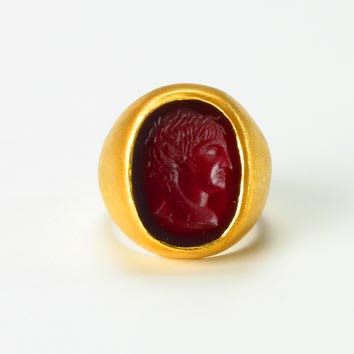Classical Revival Intaglio of the Head of a Man, 18th Century CE
Carnelian-Gold
FJ.6573
Further images
This intaglio is set is a 24 karat gold ring. Engravers of the 18th century studied ancient statuary and coins for models used on their intaglios. The portrait here bears...
This intaglio is set is a 24 karat gold ring.
Engravers of the 18th century studied ancient statuary and coins for models used on their intaglios. The portrait here bears a strong resemblance to the Emperor Claudius (reigned 41 - 54 A.D.), particularly on coins issued during the early part of his reign. Though stricken with infantile paralysis and thought to be feeble-minded, Claudius proved himself a capable administrator when he achieved the throne after the death of his nephew Caligula. Another candidate may be Germanicus, the adopted son of Emperor Tiberius (14 - 37 A.D.), who is depicted on coins not wearing a laurel wreath, as is the case on this intaglio. Whoever this man is his handsome features reveal him as someone with a strong character.
Engravers of the 18th century studied ancient statuary and coins for models used on their intaglios. The portrait here bears a strong resemblance to the Emperor Claudius (reigned 41 - 54 A.D.), particularly on coins issued during the early part of his reign. Though stricken with infantile paralysis and thought to be feeble-minded, Claudius proved himself a capable administrator when he achieved the throne after the death of his nephew Caligula. Another candidate may be Germanicus, the adopted son of Emperor Tiberius (14 - 37 A.D.), who is depicted on coins not wearing a laurel wreath, as is the case on this intaglio. Whoever this man is his handsome features reveal him as someone with a strong character.







